Lucy Bethia Walford

Lucy Bethia (Colquhoun) Walford (17 April 1845 – 11 May 1915) was a Scottish novelist and artist, who wrote 45 books, the majority of them "light-hearted domestic comedies." [1]
Life
Lucy Colquhoun was born on 17 April 1845 at Portobello, a seaside resort near Edinburgh,[2] the seventh child of John Colquhoun (1805–1885) of Luss, Dunbartonshire, author of The Moor and the Loch, and Frances Sarah Fuller Maitland (1813–1877), a poet and hymn writer.[3] Her paternal grandmother, Janet Colquhoun (1781–1846), was a religious writer, and an aunt, Catherine Sinclair (1800–1864) was a prolific novelist and children's writer.[4]
Lucy Colquhoun was educated privately by German governesses. Her reading included works by Charlotte Yonge and Susan Ferrier, and in later years Jane Austen. The family moved into Edinburgh in 1855, where guests included the artist Noël Paton, who encouraged her to take up painting. In 1868 and several succeeding years she exhibited at the annual exhibition of the Royal Scottish Academy. Her first short piece of writing appeared in the Sunday Magazine in May 1869.[4]
On 23 June 1869 she married Alfred Saunders Walford (d. 1907), a magistrate of Ilford, Essex, and they moved to London. They had two sons and five daughters.[4] The children were said to be "never put aside for her work" and "constantly with their mother." [5] She died on 11 May 1915 at her home in Pimlico, London.[4]
Works
When writing, she would seek to be as accurate as possible. Her brothers were sought out to answer any questions she had on military life. Her father was an expert on sports. The protagonist of her first novel, Mr Smith: a Part of his Life (1874) was taken from an actual man named Smith who was found dead, as described in her novel.[5] It pleased Queen Victoria and led to her being received at court. It was also admired by Coventry Patmore. By age 65, Mrs. Walford had written 45 full-length novels, including Pauline (1877), The Baby's Grandmother (1884), Stiff Necked Generation (1889), and The Havoc of a Smile (1890). She also wrote for London journals. Her last novel, David and Jonathan on the Riviera, appeared in 1914.[6]
Partial bibliography
Fiction:
| Library resources about Lucy Bethia Walford |
| By Lucy Bethia Walford |
|---|
- Mr. Smith: A Part of His Life (1874)
- Nan and Other Tales (1875)
- Pauline (1877)
- Cousins (1879)
- Troublesome Daughters (1880)
- Dick Netherby (1881)
- The Baby's Grandmother (1885)
- The History of a Week (1886)
- A Stiff-Necked Generation (1888)
- Her Great Idea (1888)
- A Mere Child (1889)
- A Sage of Sixteen (1889)
- Havoc of a Smile (1890)
- The Mischief of Monica (1891)
- The One Good Guest (1891)
- For Grown-up Children (1892)
- The Matchmaker (1893)
- A Question of Penmanship (1893)
- Ploughed (1894)
- A Bubble (1895)
- Frederick (1895)
- Successors to the Title (1896)
- Iva Kildare (1897)
- Leddy Marget (1898)
- The Intruders (1898)
- The Archdeacon (1899)
- Sir Patrick the Puddock (1900)
- A Little Legacy and Other Stories (1900)
- One of Ourselves (1900)
- Charlotte (1902)
- A Dream's Fulfilment (1902)
- David and Jonathan on the Riviera (1914)
Non-fiction
- Twelve English Authoresses (1892)
- Recollections of a Scottish Novelist (London, Williams and Norgate, 1910)
- Memories of Victorian London (London, E. Arnold, 1912)
References
- ↑ Short biography (Adam Mathew Publications); ODNB entry by Daniel Finkelstein: http://www.oxforddnb.com/view/article/41040 Retrieved 4 August 2013. Pay-walled.
- ↑ Walford. Recollections, 1910, p16.
- ↑ ODNB entry; L B Walford - birth and death details (thepeerage.com)
- 1 2 3 4 ODNB entry.
- 1 2 Black, Notable women authors, 1906, p26 ff.
- ↑ ODNB entry; Krugman, Andrew. " A Scottish Novelist; Mrs. L. B. Walford's "Recollections of a Lifetime of Sixty-five Years" (New York Times, 19 February 1911).
Further reading
- Addison, Henry Robert, et al. Who's Who: An Annual Biographical Dictionary. (A. & C. Black, 1903).
- Black, Helen C. Notable Women Authors of the Day (London: Maclaren and Company, 1906).
External links
| Library resources about Lucy Bethia Walford |
| Wikisource has original works written by or about: Lucy Bethia Walford |
- Emory Women Writers Resource Project
- Victorian Fiction Online
- Worldcat Results
- Works by Lucy Bethia Walford at Project Gutenberg
- Works by or about Lucy Bethia Walford at Internet Archive